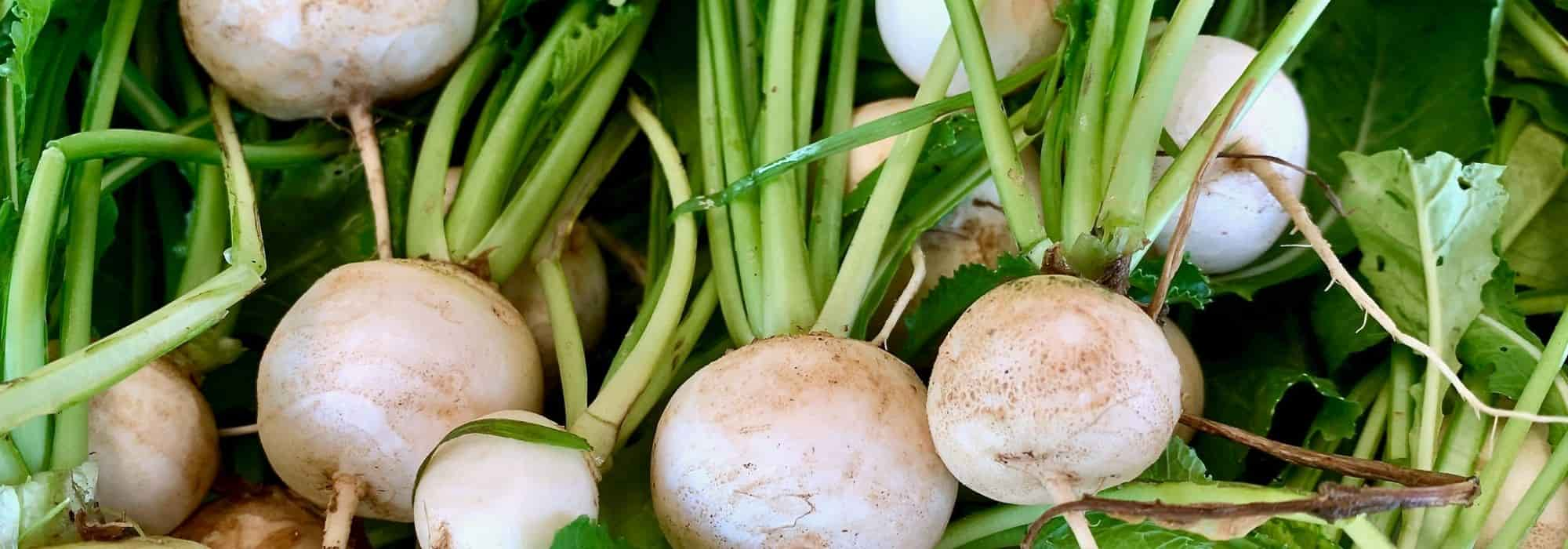
How to choose turnips?
Discover our tips to make the right choice
Contents
Centuries-old vegetable, widely consumed before the advent of the potato, the turnip (Brassica rapa) remains somewhat marginal in gardens. However, it certainly deserves a place due to its numerous nutritional benefits. Moreover, the turnip boasts a wide range of varieties with different shapes and colours that can be enjoyed raw and grated or cooked as a side dish with meat, in a stew, or in a couscous, in a ragout, or, as a supreme delight, caramelised with honey. In the garden, the turnip prefers humus-bearing, light soils, and partial shade. It thrives in regions with a temperate and mild climate. Additionally, it can be sown throughout the year to be harvested from early spring to November. If you are not yet convinced or fear its sometimes peppery taste, discover our selection of turnips chosen for their shape and colour, their sweet and mild flavour, their productivity, their harvest period, and their storage duration.
According to their shape and colour
In terms of turnips, there are two schools of thought: there are those that produce a spherical, flattened, or globose root, and those that yield long or medium-length cylindrical roots. Alongside these differences in shape, colour also plays a role. For turnips cover a palette of colours ranging from white to purple, including yellow and black.
Spherical turnips
Round, bulbous, globose… the terms are numerous to describe these spherical turnips. Turnips with fleshy tubers shaped like balls or, conversely, more or less flattened at the poles. To this shape, colour is added to help make a choice. While the turnip with a white and purple root is the most common, one can also enjoy turnips of other colours.
In white and purple: the White Turnip with Purple Collar offers a perfectly spherical root, just like the Nancy Turnip with Whole Leaf. As for the Late Auvergne Turnips or Early Auvergne Turnips, they produce slightly flattened roots with very white flesh. The Plessis F1 Turnip displays a lovely pinkish-purple colour, while the Early Flat Red Turnip with Whole Leaf hints at its reddish-purple hue.
All white: turnips can also be dressed in white, like the Giant Limousin Turnip, a beautiful local variety, or the Flat Dutch Turnip, an old variety with pure white epidermis and flesh.
In yellow: when discussing yellow turnips, one cannot overlook the Golden Ball Turnip with its well-rounded tuber, or the Goldana Turnip, an improvement on the Golden Ball, which offers firm, bright yellow flesh. The hybrid Oregon F1 stands out with its pale yellow, perfectly homogeneous round roots.
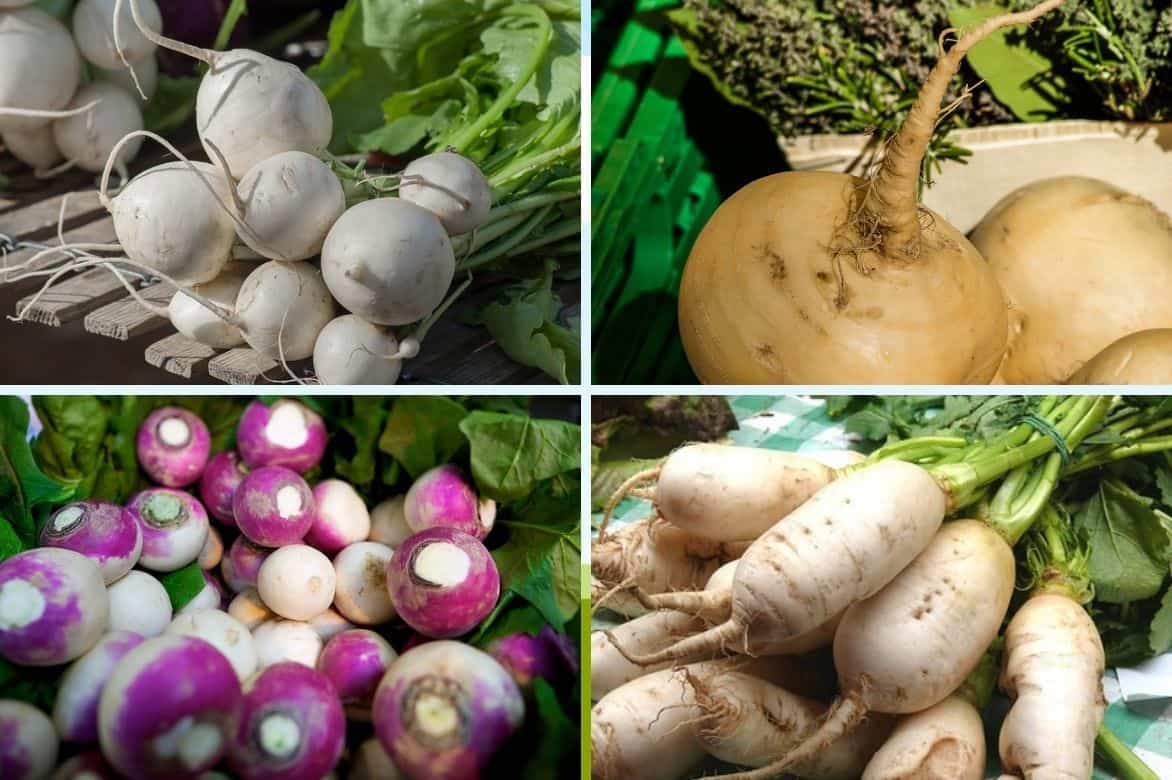
Turnips come in a multitude of shapes and colours
Long turnips
Whether long or medium-length, these turnips resemble carrots in shape. The comparison ends there, as they have neither the colour nor the flavour of this other vegetable. Long-rooted turnips are most often white, and more rarely black, and tend to have a slightly spicier flavour than round turnips.
In white: there are many varieties of long white turnips, including the Hard Winter White, the Half Long Croissy, or the Hammer Turnip. These are delicious turnips for pot-au-feu.
In black: the Long Black Turnip resembles a black radish with its black epidermis and white flesh.
Read also
Turnip: sowing, growing and careAccording to the flavour
In general, turnips have a poor reputation and perception in terms of flavour. Many find them pungent, bitter, and sometimes earthy. This is quite logical considering that they belong to the same family as the Brassicaceae (formerly known as Cruciferae), which also includes cabbages, radishes, and mustard among its ranks. However, they often possess a genuine sweetness, slightly peppery, and sometimes sugary.
Generally speaking, spring turnips are much more tender and less fibrous than autumn or winter turnips, which have a stronger taste. For instance, the Atlantic Pink Collar Turnip produces a fine and tasty flesh, just like the Early Flat Red Turnip.
If you wish to grow a turnip with firm and sweet flesh, consider the Marteau Turnip or the Long de Croissy.
The Péronne Turnip, an old variety from the Somme, is also characterised by its firm and sweet flesh, combined with great hardiness.
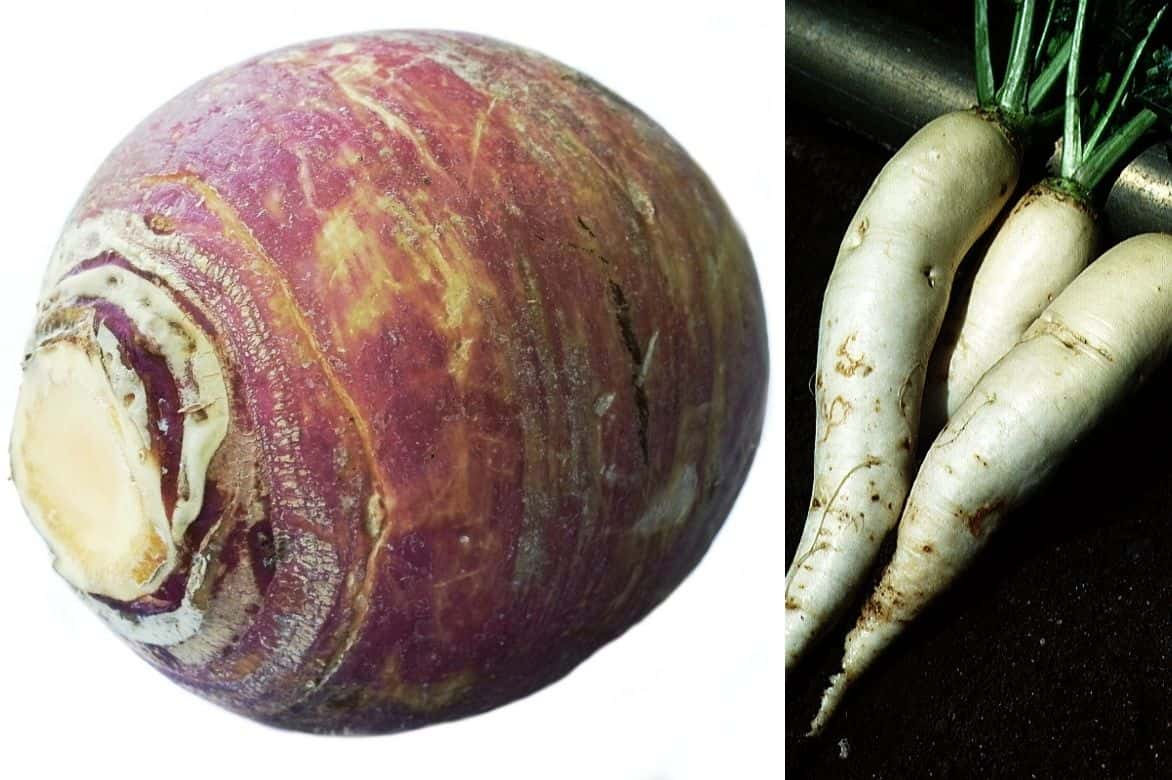
Although fundamentally different, the Péronne turnip and the Long de Croissy both have a fine and sweet flavour.
As for the Long Black Turnip, it is ideal for eating raw and grated as its flesh is very fine.
Discover other Turnip seeds
View all →Available in 1 sizes
Available in 1 sizes
Available in 1 sizes
Available in 1 sizes
Available in 1 sizes
Available in 1 sizes
Available in 1 sizes
Available in 1 sizes
Available in 1 sizes
Available in 1 sizes
According to their productivity
Derived from hybridization, the Oregon yellow turnip is a highly productive variety that produces well-rounded, bright yellow roots, particularly tolerant of cold and splitting. Its roots also offer uniform sizes and shapes that hold few surprises.
The Giant Limousin turnip is also a champion in terms of profitability, thanks in part to its very large roots that remain sweet despite their size. Similarly, the whole leaf Nancy turnip is also known for its hardiness.

The Giant Limousin turnip and the whole leaf Nancy turnip are champions of productivity
Overall, long-rooted turnips are also very productive: the White Winter Hardy is one of them, as is the Croissy turnip, which produces enormous roots.
According to the harvest period
Turnips have the advantage of being able to be sown and thus harvested for part of the year. However, some varieties are harvested in spring and summer, while others reach ripeness in autumn, or even winter.
Spring and summer varieties
These turnips produce smaller roots, they do not store as long but benefit from a milder flavour. Early varieties such as Early Auvergne Turnip, Red Flat Early with whole leaves, Milan Forcing with pink collar, or the Snowball Turnip are harvested from early to late spring, as early crops. However, they must be sown in March or April.
If you want to enjoy turnips in summer, opt for varieties like Demi-Long de Croissy, Red Milan Turnip, or Vertus Turnip.
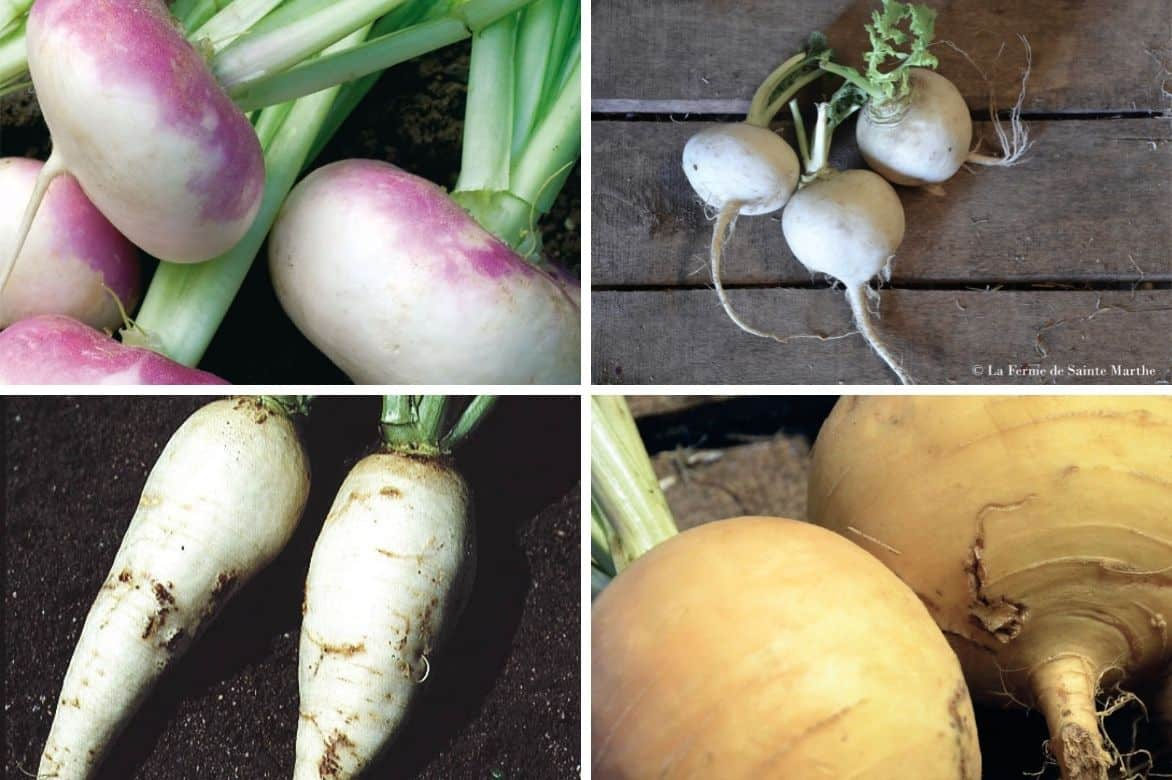 The Early Auvergne Turnip and the Snowball Turnip (©La Ferme de Sainte-Marthe) are harvested in spring and summer, while the Hard White Winter Turnip and the Golden Ball are for autumn and winter.
The Early Auvergne Turnip and the Snowball Turnip (©La Ferme de Sainte-Marthe) are harvested in spring and summer, while the Hard White Winter Turnip and the Golden Ball are for autumn and winter.
Autumn and winter varieties
These are turnips that benefit from better storage. They are sown in summer for a harvest 2 to 3 months after sowing. The Hard White Winter Turnip is a clear choice for a harvest from September to November, as well as the Flat Dutch Turnip, the Péronne Turnip, also known as Montesson Turnip, or the Late Auvergne Turnip. Not to mention the remarkable Golden Ball Turnip.
According to the shelf life
Spring and summer turnips can be stored for a few days in the vegetable drawer of the refrigerator. In contrast, autumn and winter varieties can be kept for much longer. To ensure their long storage, they should be harvested before the frost and left to dry, that is, to dry on the ground, for one to two days. If the weather is too humid, allow them to dry in a ventilated area.
Next, these turnips are placed in a silo, in a wooden crate or a large plastic container filled with sand. This silo should be stored in a frost-free, dark cellar.
For further reading
Discover our full range of turnips.
Learn everything you need to know about sowing, cultivating, maintaining, and harvesting turnips with Aurélien.
- Subscribe!
- Contents
































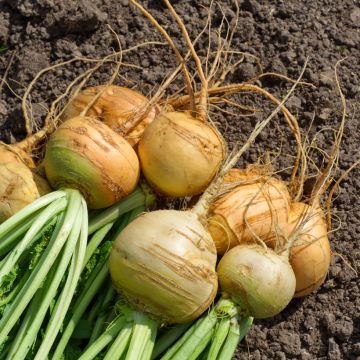

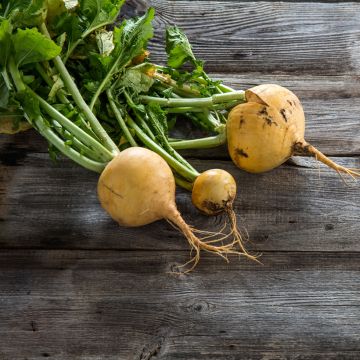
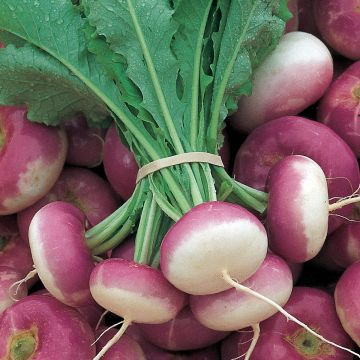
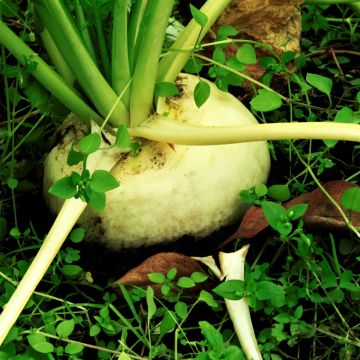
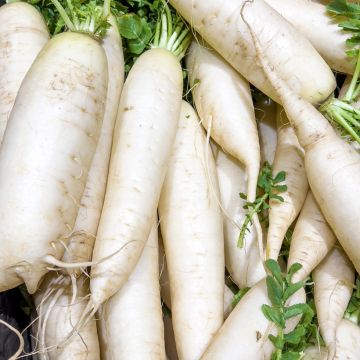

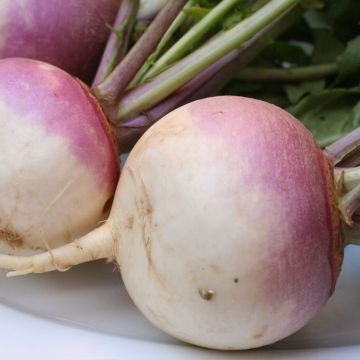
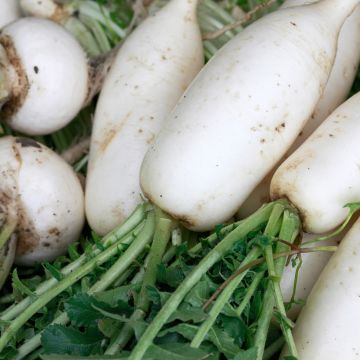

Comments